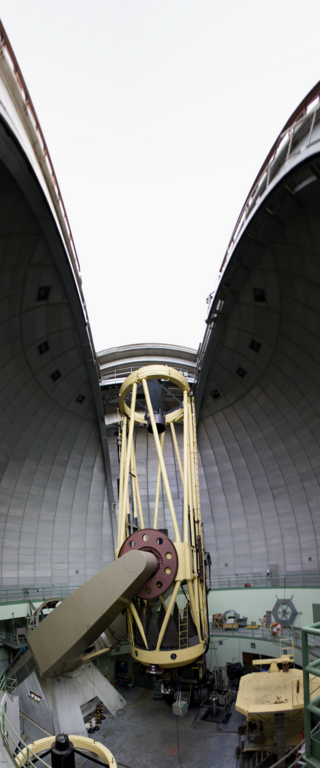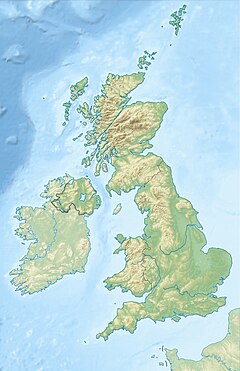
The United Kingdom Infra-Red Telescope (UKIRT) is a 3.8 metre (150 inch) infrared reflecting telescope, the second largest dedicated infrared telescope in the world. It is located on Mauna Kea, Hawai'i as part of Mauna Kea Observatory. Until 2014 it was operated by the Joint Astronomy Centre in Hilo. It was owned by the United Kingdom Science and Technology Facilities Council. UKIRT is currently being funded by NASA and operated under scientific cooperation between Lockheed Martin Advanced Technology Center, the University of Hawaii, and the U. S. Naval Observatory. The telescope is set to be decommissioned after completion of the Thirty Meter Telescope as part of the Mauna Kea Comprehensive Management Plan.

The Mount Wilson Observatory (MWO) is an astronomical observatory in Los Angeles County, California, United States. The MWO is located on Mount Wilson, a 5,710-foot (1,740-meter) peak in the San Gabriel Mountains near Pasadena, northeast of Los Angeles.

Steward Observatory is the research arm of the Department of Astronomy at the University of Arizona (UArizona). Its offices are located on the UArizona campus in Tucson, Arizona (US). Established in 1916, the first telescope and building were formally dedicated on April 23, 1923. It operates, or is a partner in telescopes at five mountain-top locations in Arizona, one in New Mexico, one in Hawaii, and one in Chile. It has provided instruments for three different space telescopes and numerous terrestrial ones. Steward has one of the few facilities in the world that can cast and figure the very large primary mirrors used in telescopes built in the early 21st century.

Stardome Observatory & Planetarium is a public astronomical observatory and planetarium situated in Maungakiekie/One Tree Hill Domain in Auckland, New Zealand.

Bayfordbury, Hertfordshire, is a large Grade II* listed country house with surrounding parkland, and the location of a University of Hertfordshire campus, housing its biology/geography field station and observatory.

The Indian Astronomical Observatory (IAO) is a high-altitude astronomy station located in Hanle, India and operated by the Indian Institute of Astrophysics. Situated in the Western Himalayas at an elevation of 4,500 meters (14,764 ft), the IAO is one of the world's highest located sites for optical, infrared and gamma-ray telescopes. It is currently the tenth-highest optical telescope in the world.
The Fick Observatory was an astronomical observatory owned and operated by Iowa State University. Located southwest of Boone, Iowa, it was named after Davenport, Iowa, amateur astronomer Erwin W. Fick. The observatory closed in 2015.

Konkoly Observatory is an astronomical observatory located in Budapest, Hungary is part of the Research Centre for Astronomy and Earth Sciences and belongs to the HUN-REN Magyar Kutatási Hálózat. Konkoly Observatory was founded in 1871 by Hungarian astronomer Miklós Konkoly-Thege (1842–1916) as a private observatory, and was donated to the state in 1899. Konkoly Observatory, officially known as HUN-REN CSFK Konkoly Thege Miklós Csillagászati Intézet in Hungarian, is the largest astronomical research institute in Hungary, and hosts the largest telescopes in the country. The Observatory has more than 60 researchers, a quarter of them are non-Hungarian.
UNA Observatory is an astronomical observatory owned and operated by the University of North Alabama. It is located in Florence, Alabama (USA). It has 2 telescopes, a Celestron 0.35 m Schmidt–Cassegrain telescope. The UNA Planetarium is a 65-seat planetarium with a Spitz A3P projector and East Cost Control Systems controller.
The William G. and Retha Stone Baker Observatory is an astronomical observatory owned and operated by Missouri State University. It is located in Marshfield, Missouri.

The C. Donald Shane telescope is a 120-inch (3.05-meter) reflecting telescope located at the Lick Observatory in San Jose, California. It was named after astronomer C. Donald Shane in 1978, who led the effort to acquire the necessary funds from the California Legislature, and who then oversaw the telescope's construction. It is the largest and most powerful telescope at the Lick Observatory, and was the second-largest optical telescope in the world when it was commissioned in 1959.

The Sir Thomas Brisbane Planetarium is located on the grounds of the Brisbane Botanic Gardens in the suburb of Mount Coot-tha, Brisbane, Queensland, Australia. The Planetarium was officially opened on 24 May 1978.

Michigan State University Observatory is an astronomical observatory owned and operated by Michigan State University. It is located south of the Michigan State University campus in East Lansing, Michigan (USA), near the corner of Forest Rd and College Rd. It has a Cassegrain telescope in its single dome. Built by Boller and Chivens, the Michigan State University telescope was commissioned in 1969 and entered regular operation in 1970. In 1974, what was at the time a state-of-the-art Raytheon Microcomputer was installed to function as a data gathering and control system. Originally, single channel photoelectric photometry and photography using plates or film were the means of acquiring data. The observatory was closed from 1981 until 1986, at a time when the university was having financial difficulties. It was reopened in the spring of 1986 on the occasion of the return of Comet Halley and has been in regular operation ever since. Since the 1980s, a CCD camera has been employed as the main instrument and the Raytheon computer has been retired. The International Astronomical Union has assigned the MSU Observatory identification code 766.

The Norman Lockyer Observatory, the Lockyer Technology Centre, and the Planetarium, is a public access optical observatory 1 mile (1.6 km) east of Sidmouth, East Devon in South West England. It houses a number of historical optical telescopes, including the Lockyer Telescope, and is operated by Norman Lockyer Observatory Society (NLOS).

The Givatayim Observatory is a public observatory that was founded in 1968 by the Israeli Astronomical Association and the Givatayim municipality.
The SUNY Oneonta Observatory is an astronomical observatory in Oneonta, New York, home to the state's largest optical telescope and one of the largest publicly open east of the Mississippi, a one-meter Newtonian reflector constructed by JMI Telescopes of Lakewood, Colorado.

The ÇOMÜ Ulupınar Observatory (UPO) is a ground-based astronomical observatory, which was established in 2001 and formally opened on 19 May 2002. It is also known as Çanakkale Observatory or the University Observatory. The Ulupınar Observatory is part of the Çanakkale Onsekiz Mart University (ÇOMÜ) Faculty of Science and Arts.

The Ankara University Observatory (AUG), is a ground-based astronomical observatory operated by the Astronomy and Space Sciences Department at Ankara University's Faculty of Science. Established in 1959 by Dutch astronomer Egbert Adriaan Kreiken in Ahlatlıbel, Ankara. Currently, it consists of nine optical telescopes and a radio telescope, which is currently taken out of service. Old instruments are displayed in a museum at the observatory.

The Ege University Observatory is a ground-based astronomical observatory operated by the Astronomy and Space Sciences Department at Ege University's Faculty of Science. Formally opened on June 22, 1965, it is located in Kurudağ at Buca district, 10 km (6.2 mi) east of Izmir in western Turkey. The telescope domes of the observatory are situated at an altitude of 800 m (2,600 ft) while the main building is erected at 632 m (2,073 ft).

The Prairie Observatory was constructed near Oakland, Illinois by the University of Illinois at Urbana-Champaign's Department of Astronomy. The site was adjacent to Walnut Point State Park and provided an accessible but dark sky site only 35 miles from campus. The telescope went into operation in January 1969 and closed on April 1, 1981. In early 2024, the building was demolished by the Illinois Department of Natural Resources due to hazards the building posed to public health.






















